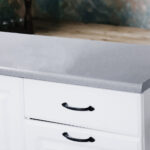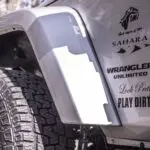Whether you’re a seasoned professional or newbie, we all want the outcome of our work to look good. Having the right tools for any job is critical to that outcome.
When It comes to wrapping your car, there are many different tools to choose from.
Not all of them are essential to getting the job done adequately. But even the nonessential items can save your time if used properly. And time is the one thing we can’t buyback.
Depending on the type of installer you are. Some tools might be more necessary than others.
All the tools listed are based on doing a full or partial car wrap. Depending on If you’re doing full or partial, then some of the tools on this list might become more vital than others for saving your time and effort.
Heres a list of essential and nonessential car wrapping tools
Squeegee – Flexible and stiff
There are many different types of squeegees. Some are better for gliding over the vinyl to release air. Others are great for working the vinyl into seams and grooves. Squeegees come in a variety of sizes, shapes, and flexibility.
Application gloves
Application Gloves are essential for forming and finessing vinyl into deep recesses and curves of a vehicle. They also protect against the transfer of oils and other contaminants from your skin. Be careful with the one-size-fits-all glove.
You want a glove that fits snug, so there are no snags, and your finger and hands can glide across the vinyl.
Heat gun
One of the more essential tools in the wrapping arsenal. It might not get used a lot in many wrapping jobs, but it is quite vital. In terms of the price range, a heat gun can cost anywhere from $30 – $500. A good heat gun will start from $100 and up.
In the wrapping world, they will all get the job done adequately. The significant difference between the price is the build-quality. Typically the inexpensive brands are internally made out of ceramic.
The ceramic heat guns tend to break easily over their higher-priced counterparts. Due to the nature of a car wrapping environment, equipment tends to fall and hit the ground from time to time.
This may result in the ceramic cracking and causing the heat gun not to function. Inexpensive heat guns are great if you’re starting and don’t have a lot of money to spend. Or maybe you want to wrap your own vehicle, and you don’t if you’ll use it again.
Here’s a list of features you might find in mid and high-end heat guns.
● One-piece injection molding
● Intelligent digital display temperature control
● Air outlet
● Magnetic
● Automatic heat adjustment
● built-in infrared thermometer
● Built-in stand
● Higher heat range
● Battery-powered heat gun
● Variable heat settings
● Rubberized housing
● Cold air inlet
● Protective cover
● Special rubber power cord
● Temperature/gas flow adjustment button
● Gas flow program key
● Memory system program key
● LCD display
● Shockproof non-slip rubber handle
● Hook slot
● Residual warning light
● Power cord connection end
Light duty utility knives
Light duty utility knives are the preferred type of knives when working with vinyl on vehicles. Because of the size, angle of the blade, and time it takes to replace blades.
A smaller blade reduces the chances of cutting the car. It is best practice to use a utility knife that loads snap-off blades. You can go through sever blades when doing a full vehicle wrap.
When a section of the blade gets dull, you have a new section right behind it. No need to waste time with other style utility blades that you have to unscrew to insert a new blade.
9mm 30 degree blades are ideal for typical wrapping jobs.
Knifeless Cutting Tape
Also known at trim line tape is a transparent tape with a filament in the center. Some brands offer an off-center filament.
This tape is applied along the bodyline or other parts of the vehicle to make detail cuts. You have more control when using cutting tape. It helps to create a clean-cut, so when you segue the vinyl, it visually looks seamless.
You can also use cut tape for cutting out intricate shapes on the vehicle.
It is always best to make sure that the vinyl is laid firmly to the contour of the tape. Loosely applied vinyl will result in a jagged edge.
IR Digital thermometer
Infrared Thermometers are vital when it comes to post-heating. Many types of vinyl come with a memory feature.
This allows the vinyl to lock into a certain position after you’ve stretched it.
When it’s heated at its specified temperature, typically 90C, it will hold it’s position better and lessens the likelihood of pealing from the recessed areas.
When post-heating an area, there is no way for us to know when a specified temperature is reached. Using a device like an Infrared thermometer gives you the closes possible reading.
Tape measure
Tape measures are required to get the measurements, so you’re not cutting the vinyl short or wasting it by cutting too much.
It is best to keep the adjustable metal end of the tape measure off the car. Resting or dragging the tape measure on the vehicle can lead to scratches.
It’s a good idea to invest in a broader tape measure to prevent the dropping of metal end on the vehicle as you’re trying to measure it.
There will be situations where a magnetic rope tape measure will be better to use. When measuring the bumper, it is unsafe and hard to bend the tape around the curves of the bumper.
A magnetic rope tape measure helps to get a precise measurement without the risk of scratching the vehicle.
Snitty Vinyl Cutting Knife
A snitty is a tool for cutting large sheets of material. It holds a standard razor blade that is enclosed in plastic. It has an embedded slot so that it only cuts when materials are guided directly into its slot.
Having a snitty is like a mini insurance policy. Some wrap installers use a regular utility knife when cutting off the excess vinyl on a vehicle. No matter how professional you are or how steady your hand is, you can accidentally cut the car. We’re all human, and we make mistakes.
Magnets
Having an extra hand to help you position large sheets of vinyl on the car is not always available. It is crucial to find the right positioning when lining up the vinyl on the vehicle.
Magnets are a game-changer when it comes to positioning and keeping the vinyl on the car as you make adjustments. Magnets speed up the process of getting the job done.
On the downside, magnets are not always a viable option due to some cars having an aluminum body. The magnets will not stick to the car! The worse case, if you can’t find another set of hands to hold the vinyl as you position it, you will need to use painters tape.
It’s a good idea to have a few sets of magnets readily available. You might end up in a situation where you will need to put magnets in multiple locations to hold that right position for you. The more magnets you have access to, the better.
Felt squeegee buffer strips
Having an excellent buffer for your squeegee can make the difference when it comes to installing vinyl. It helps the squeegee glide and dramatically improves applying the material.
Here are a few types of buffer strips you can find on the market.
● Wing tipped buffer strips
● Straight rectangle buffer strips
● Dry buffer strips
● Wet buffer strips
Tweezers
These are useful for many situations when wrapping. They can help you to maneuver vinyl in or out of a deep recess on the vehicle. It’s also helpful when removing remnants of excess vinyl bits where your fingers cannot access.
They come in a wide variety of tips. Some of the finer tips are sharp and comes with a protective cover. If you have it in your pocket, It’s a good idea to make sure the protective cover is on.
The broader tip Tweezers are suitable for pulling the end of the vinyl. You might not wear gloves because you need the full dexterity of your hands. Using broader tip tweezers can prevent contaminate from your hands from getting on the vinyl and compromising the stick.
Microfiber cloth
There are many towels on the market you can use to wipe. But when it comes to the longevity and condition of your paint of vinyl Microfiber cloth is the way to go.
Using a standard cloth of paper towels can accumulate dirt when wiping and lead to scratching the vehicle.
There are three stages of car care when thinking about when wrapping a vehicle — cleaning the vehicle’s original paint, cleaning during insulation, cleaning after the vinyl has been applied.
It’s recommended to use a 40 to 50 GSM(grams per square meter) microfiber cloth. The higher the GSM, the higher the number of fibers, which increases weight, thickness, and absorption.
Compressor
When It comes to vehicle preparation having a compressor on hand is useful.
They are great for blowing water and dirt out of the seams of the vehicle.
When using your compressor, make sure to have a variety of nozzle attachments. It will help speed up the process of cleaning the vehicle.
Painters tape
You can you painters tape or masking tape in a variety of ways when installing vinyl. It helps with the process of tucking the vinyl around things like door handles and headlight molding and other items.
Tack reducer
Tack reducer is a liquid that is applied to the vehicle to reduce the adhesion of the vinyl on the vehicle. You might need to lift the vinyl of the vehicle several times to position it in the right spot.
Without tack reducer, the vinyl can adhere very firmly, causing the vinyl to wrinkle when trying to lift it off to reposition it.
Isopropyl alcohol 70%
Cleaning your vehicle with Isopropyl alcohol 70% will ensure maximum adhesion. Oils and other contaminants build-up and stay on your vehicle even after a carwash.
So you want to make sure to remove the build-up of contaminants to make sure your vinyl will not come undone over time.
Wax pencil or dry erase markers
Having a writing tool is vital to identify precise look on the vehicle where the vinyl needs to sit. It’s best to use some that are not permanent and can be removed easily.
Was pencel take a bit of alcohol to remove it but dry erase markers wipes of with your finger. Bost writing tools will remove without leaving a trace.
Utility Gadget Belt
Speed is important, so having fast access to your tools is essential. Utility belt gives you that quick access.
I tend to forget where I put things all the time! Having my most essential tools on me cuts down on time it takes for me looking for tools I’ve missed placed.
It also keeps tools away from the ground where tools can get stepped on and become damaged.
Tucking tools
Tucking tools allows you to work the vinyl into different parts of the vehicle. These tools not only allow you to tuck, but it lifts rubberized areas of the vehicle seams so that you can guide the vinyl.
Hardware Removal and Trim removal Tools
If the goal is to create a clean seamless look, then removing hardware from a vehicle is ideal.
Having all the hardware off makes the installer’s job much easier. You can remove and wrap whole parts.
You don’t need to worry about maneuvering around difficult to wrap parts. Just focus on wrapping the vehicle.
having the right set of tools help speed up the removal process so you can get wrapping faster.
When removing parts of the vehicle, the existing auto clips tend to break or warp out of shape. It’s a good idea to have a backup assortment of auto clips and retainers for replacement.








